Learn how to make an authentic pozole rojo recipe at home. This rich and spicy red chili-infused soup is a beloved classic from Mexican cuisine, it is perfect for gatherings and as a soul-warming comfort food. Get ready to savor the vibrant taste of Mexico in every spoonful!
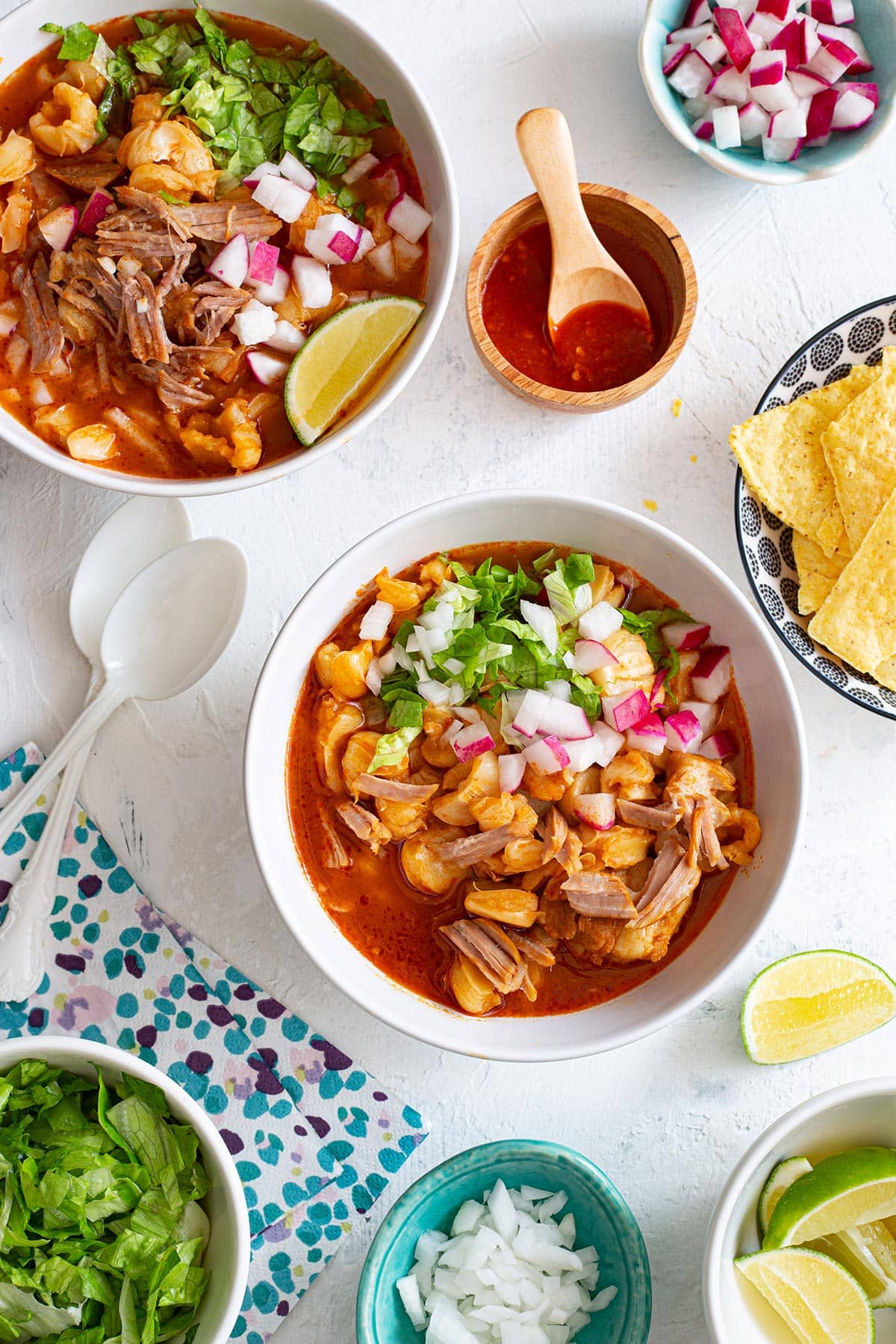
Pozole Rojo is a traditional Mexican stew made with hominy, pork meat, and red chili sauce. It’s usually served with toppings like shredded cabbage, lettuce, onions, radishes, lime juice, and hot salsa.
The key ingredient that gives pozole rojo its distinctive red color is dried red chilies, such as guajillo, ancho, or pasilla chilies, which are rehydrated and blended to create a red sauce.
What makes this pozole recipe authentic is the use of cacahuazintle corn. This type of corn is a traditional and ancient variety of maize that is native to Mexico. It is characterized by its large, plump kernels and unique culinary characteristics.
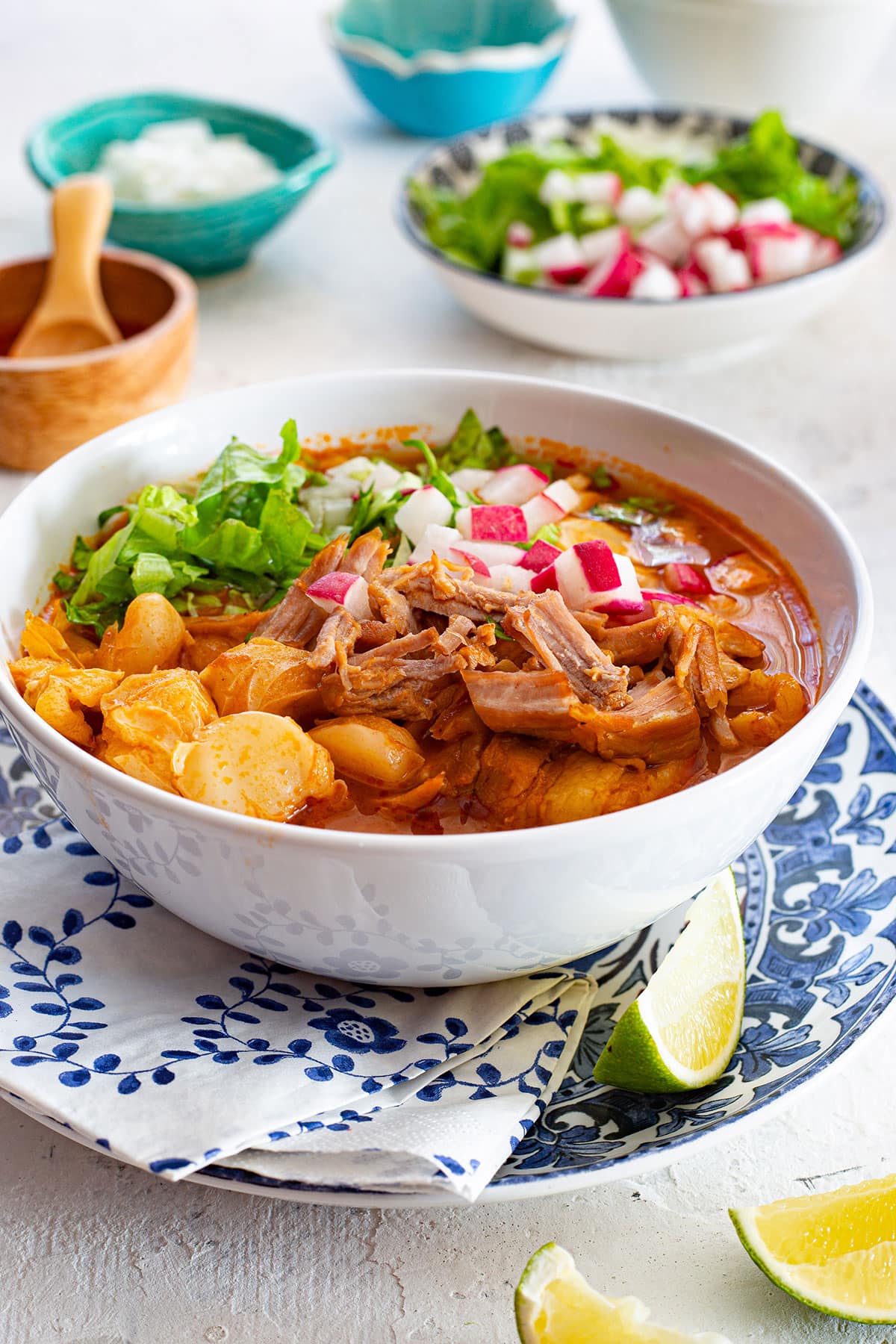
Ingredients
- MEAT: Pork is the most common and traditional choice of meat for red pozole. You can use various cuts of pork, such as pork shoulder, belly, pork ribs, pork shank, and even pork rind. If you prefer leaner meat, you can use pork loin too.
- CACAHUAZINTLE CORN: You can find this ingredient at some Mexican or Latin American grocery stores or on Amazon. Or you can substitute it with canned hominy or Peruvian mote corn in a pinch.
For the red chile sauce:
- CHILIES: Guajillo chile is the most used to make this recipe, those are dried peppers popular in Mexican cuisine. You can substitute them with guajillo paste, guajillo powder, or ancho chiles. Anaheim dried peppers are also a good substitute.
- ONION: White or red onion.
- SPICES & SEASONINGS: A whole garlic head, oregano, cumin seeds, bay leaves, black peppercorns, and salt.
How To Make Pozole Rojo
Step 1. Soak the corn
Before going to bed, place the corn into a large bowl and cover it with plenty of water. The next day you will notice that the corn has softened a bit. Discard the soaking water and wash the corn thoroughly with cold water.
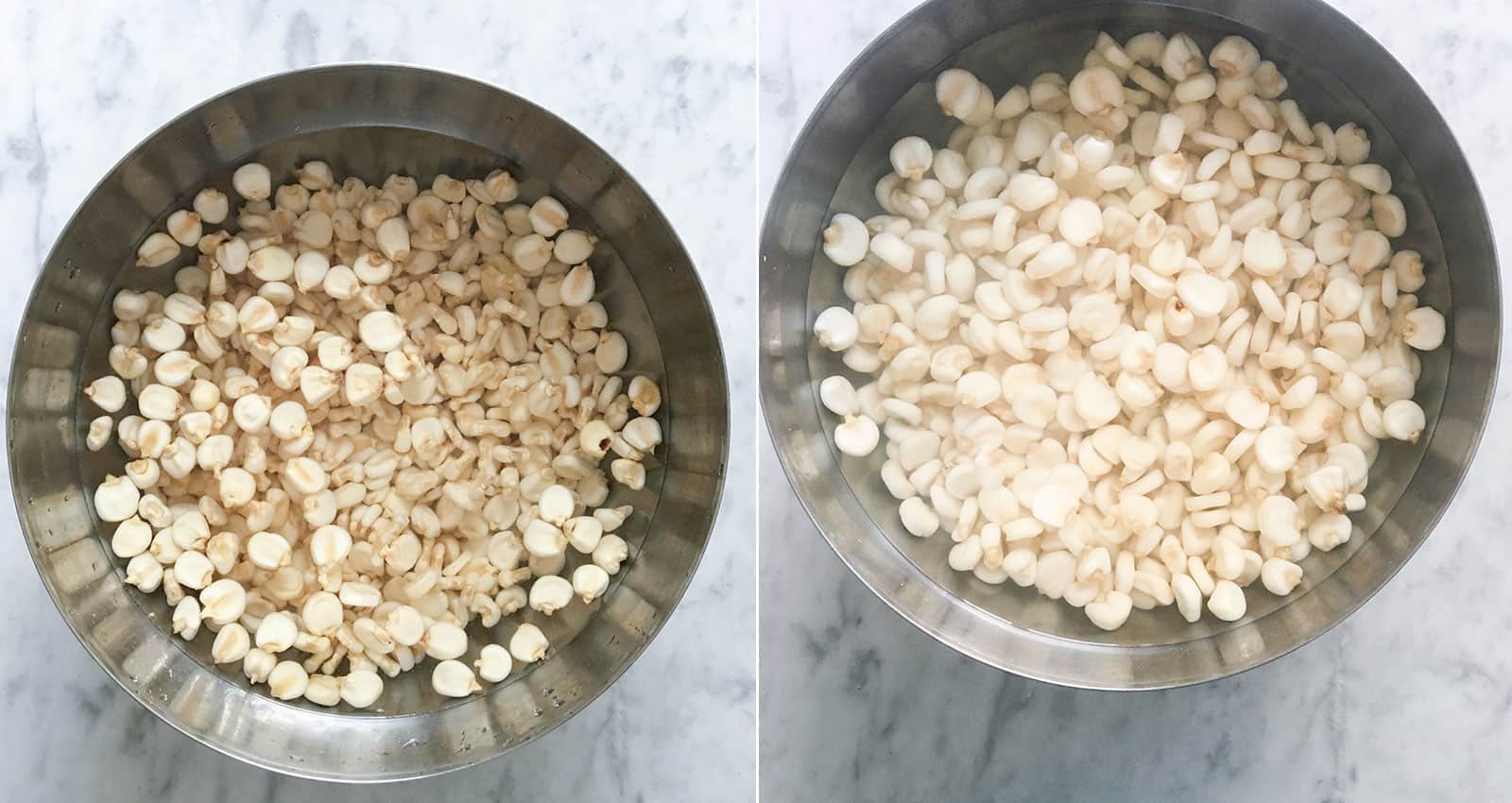
Tip: If you use canned hominy, just rinse it with cold water and start the recipe with the chile sauce preparation.
Discard the little “heads” on the corn. If you want the kernels to bloom then you need to “de-head” the kernels. De-heading means picking off those little tips with your fingers.
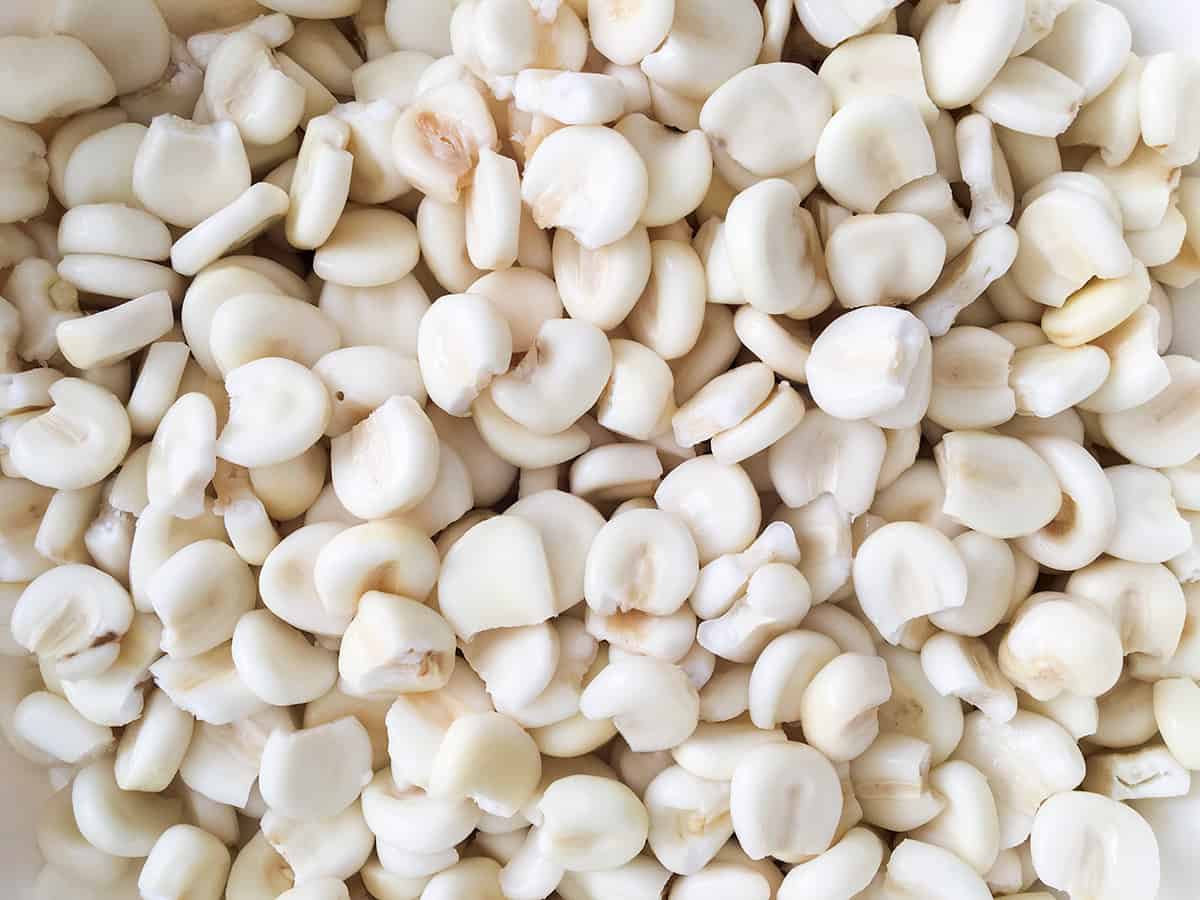
Note: This is a time-consuming step since you have to do it to every single kernel. Still, I suggest not skipping if you want a soft and tender texture on the corn.
Step 2. Cook the corn
Place soaked hominy corn in a large pot and cover it with 2 inches (5cm) of water.
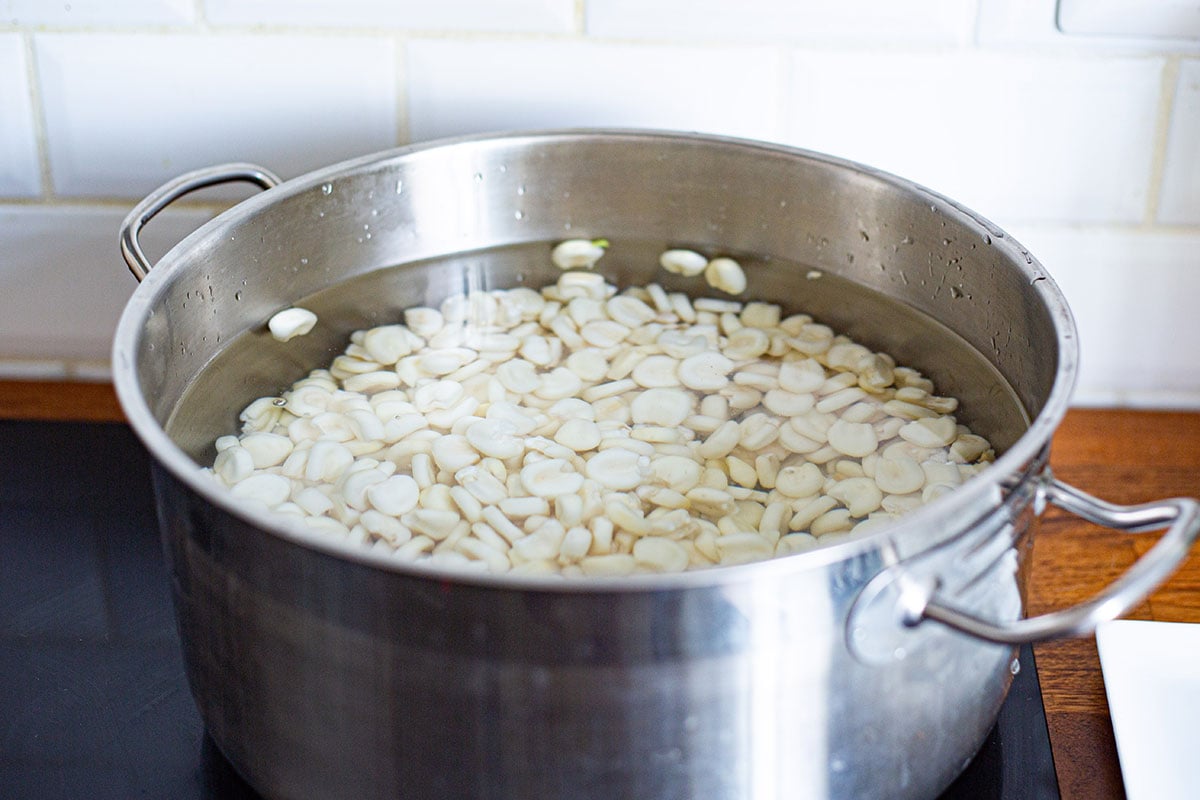
Cook over medium heat for about 3 hours or until the grains are slightly tender.
After three hours the corn will start to “bloom” and you will notice because most of the kernels will be popping and the broth will have a thick consistency.
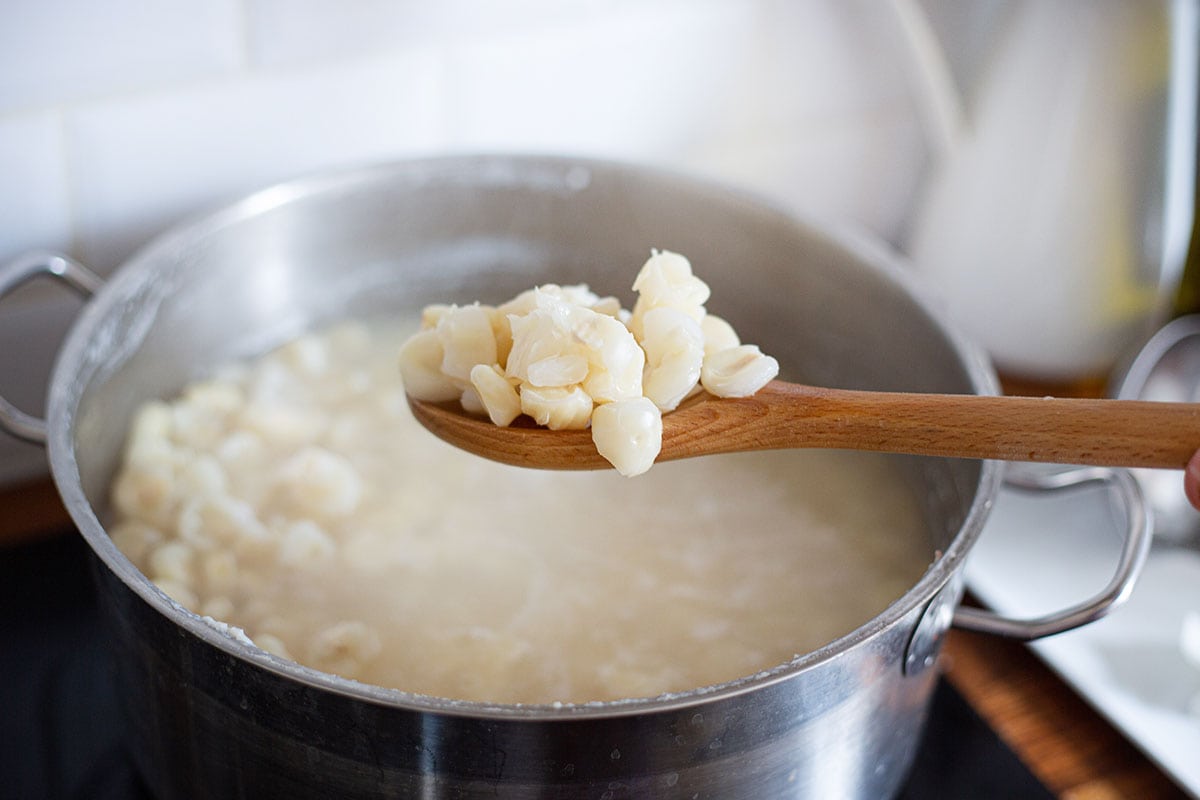
Step 3. Make the sauce
While the hominy is cooking, clean the dried chiles and place them in a bowl.
Cover them with hot water and allow them to soak for about 20 minutes or until they are nicely soft.
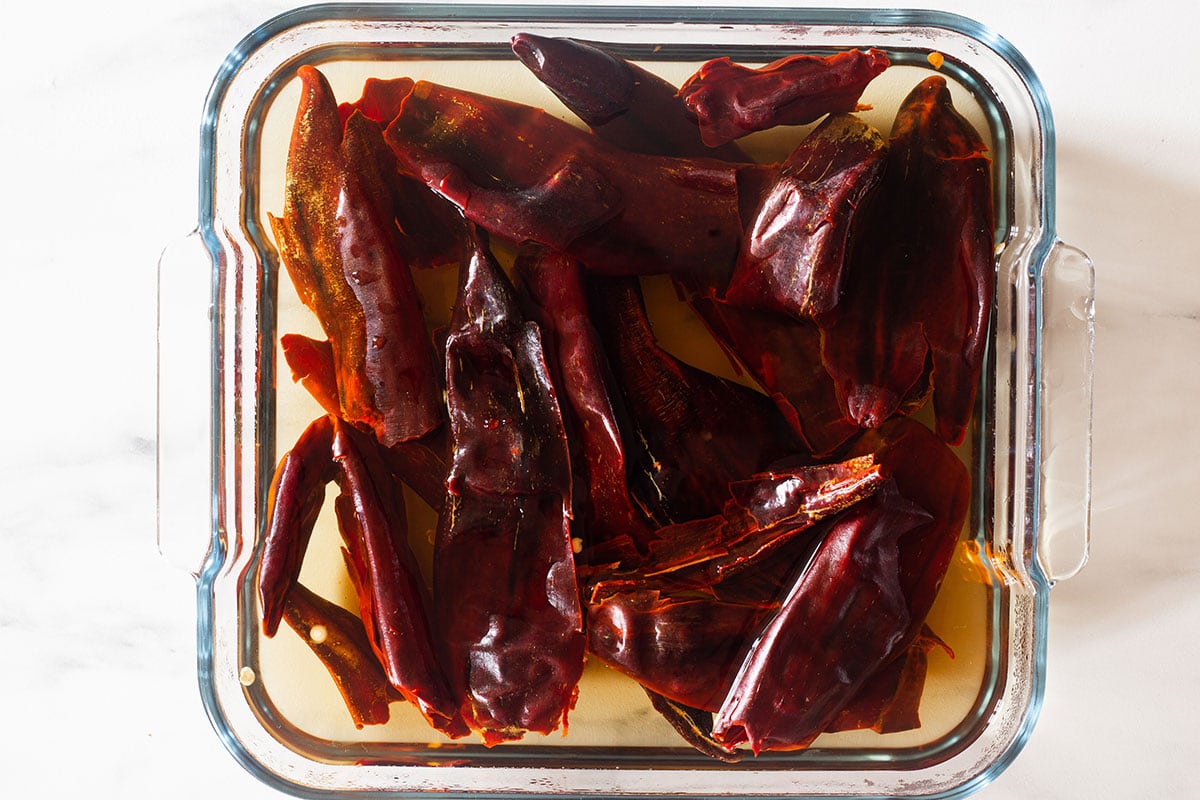
Drain the chilies and place them in a blender along with onions, garlic, oregano, cumin, bay leaves, and pepper.
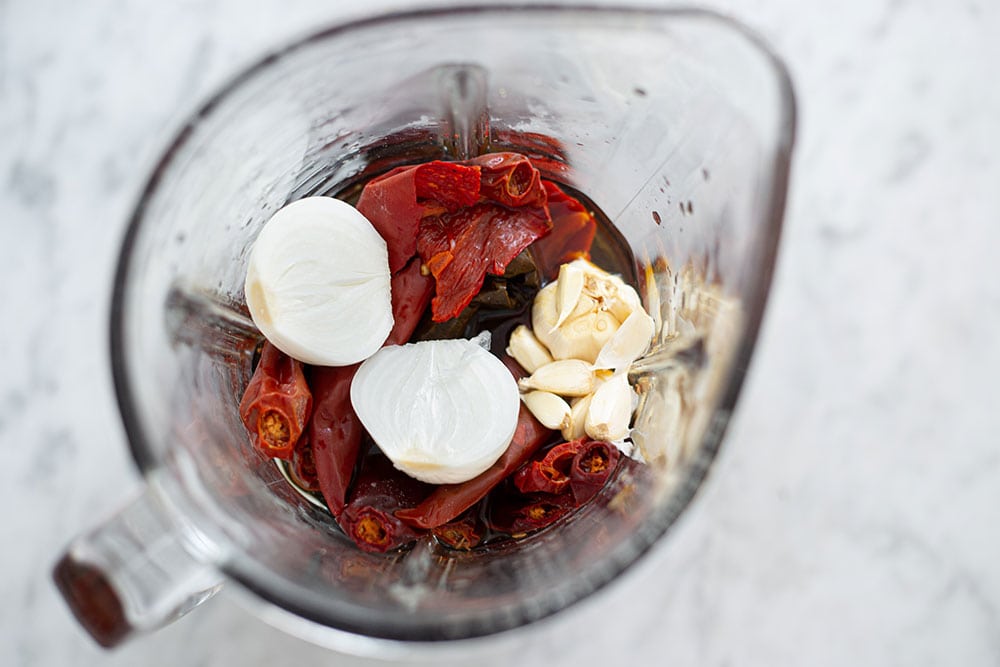
Pour one and a half cups of water and blend until you’ll get a smooth sauce. Strain the sauce into the pot with hominy and stir to combine.
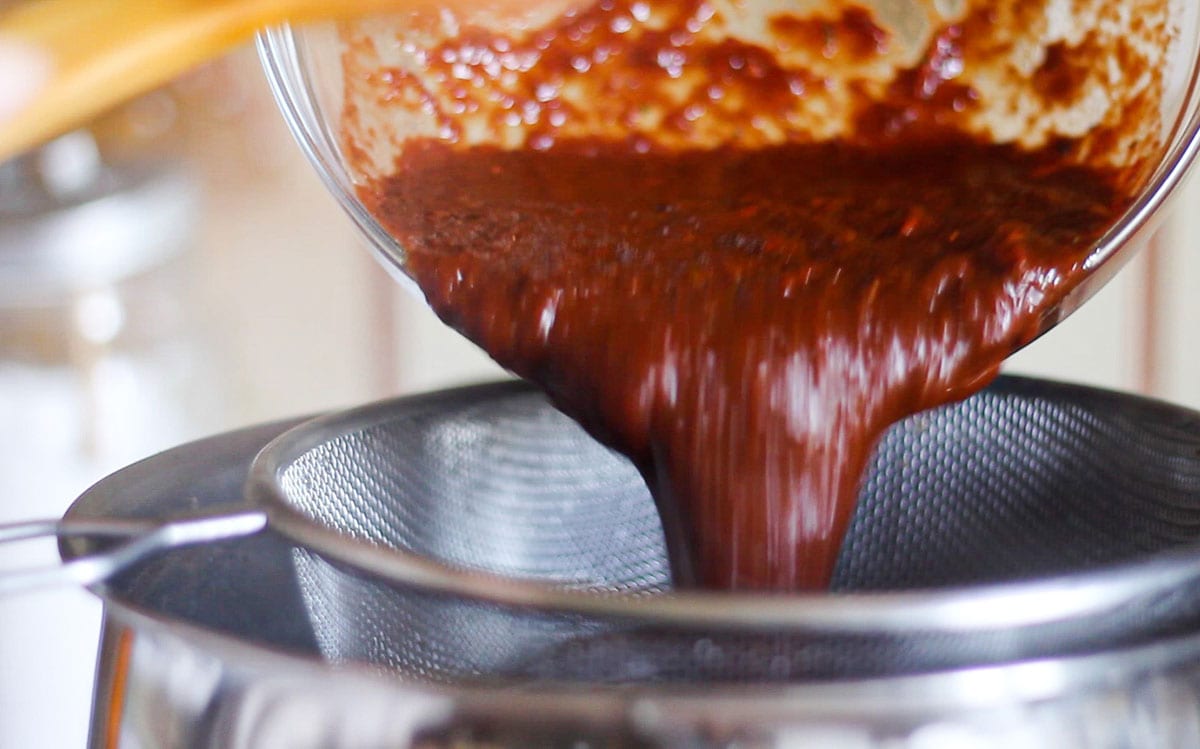
Step 4.- Cook the pork meat
Add the pork meat and enough water to cover all the ingredients and mix well. Season with salt and bring to a simmer.
Cook from 2 to 2 1/2 hours over medium-high heat, making sure the meat is always covered with broth. Once the meat and kernels are nicely tender, adjust with salt and turn off the heat.
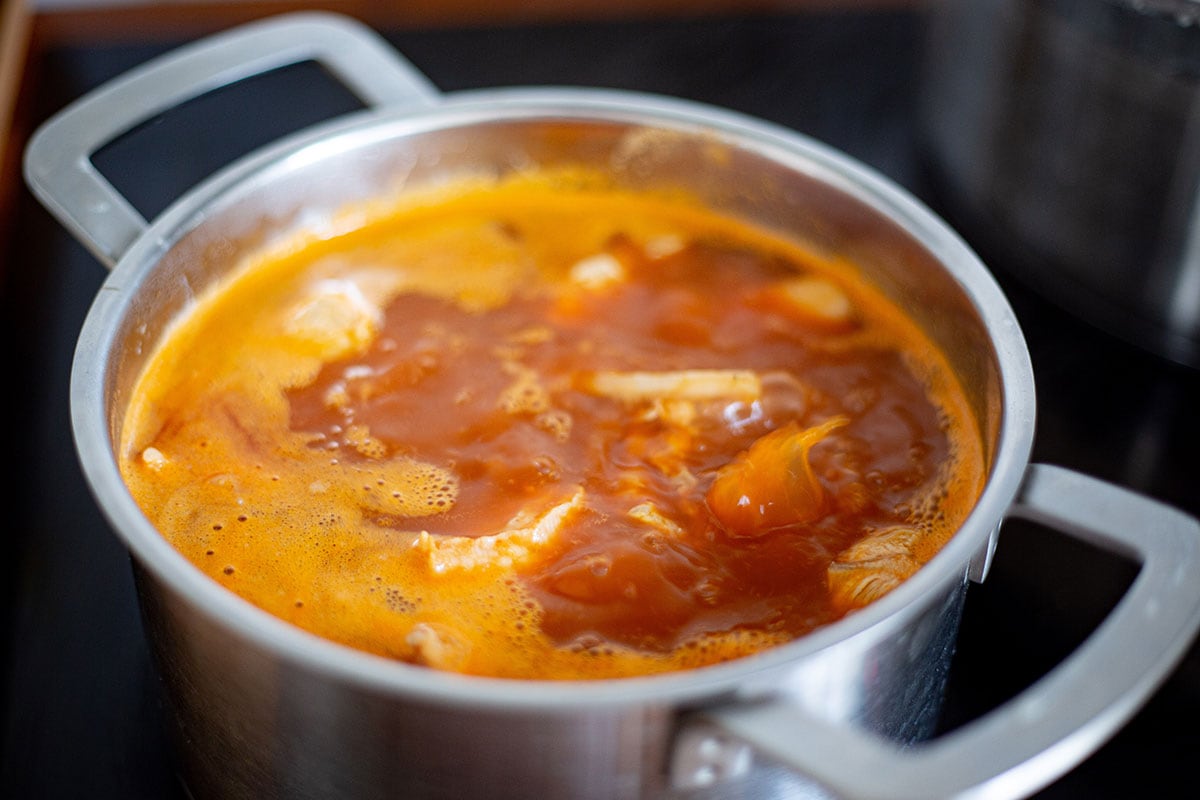
Pozole is ready, serve immediately with toppings like onion, radishes, salsa, and a squeeze of lime.
Expert Tips & Notes
- The corn I used had already undergone the nixtamalization process. It’s essential for you to check if the corn you purchase is ready to cook otherwise you’ll need to do it yourself using lime (calcium hydroxide).
- Balance the heat of the dish by varying the number of chilies you use. Removing the seeds and membranes from the chilies can also reduce the spiciness.
- On the contrary, if you want to add more heat add some arbol chiles to the sauce.
- Choose a pot that is large enough to comfortably hold all the ingredients without overcrowding. Pozole is often made in large batches, so a stockpot or Dutch oven with a capacity of 7 to 10 quarts or more is ideal, depending on the quantity you plan to prepare.
- If you notice that the meat is well cooked but the kernels are not, take out the meat and place it in a bowl, then continue cooking the hominy until done.

What to Serve With Pozole
Pozole rojo can be served with a large variety of toppings that depends on personal preferences and sometimes traditions, here are some of the most popular:
- Chopped lettuce or cabbage.
- Chopped onions.
- Sliced or diced radish.
- Tostadas.
- Avocado.
- Crispy potato tacos.
- Diced tomatoes.
- Chopped cilantro.
- Hot salsa. We recommend this salsa macha or this peanut sauce.
- Lime juice.
Store & Reheat
Pozole rojo leftovers can be stored in the fridge for up to 5 days or in the freezer for up to 3 months. You can store the meat in a separate container or everything together for convenience.
I don’t recommend leaving the leftovers out of the fridge overnight as they can easily spoil, especially in a warm environment.
To reheat first thaw it in the fridge (if frozen), then transfer it to a pot and bring it to a gentle boil. Simmer until is heated through and serve with your favorite toppings.
FAQ
What are the 3 types of posole?
The 3 more popular types of pozole in Mexico are red pozole (pozole rojo), white pozole, and pozole verde.
Is pozole verde or rojo better?
Whether pozole verde or pozole rojo is “better” is a matter of personal preference, and both variations have their own unique and delicious qualities. Red pozole has a robust, smoky, and spicier flavor due to the dried red chilies. The broth tends to be richer and more intense in taste.
Pozole verde has a bright, tangy, and slightly herbal flavor from the tomatillos and fresh green chilies. The green broth can be milder in spice compared to the red version.
More Mexican Soups
If you enjoyed this pozole rojo recipe, please take a minute and rate it below in the comments. Also, don’t forget to share and follow this blog on Instagram, Facebook, Pinterest, and YouTube.

Authentic Pozole Rojo
Equipment
- 1 7-quart pot
Ingredients
- 2.2 pounds cacahuazintle corn (or 3 cans of hominy, 15 oz each)
- 4.5 pounds pork meat (pork shoulder, loin, and belly)
- 1.1 pounds pork rind
For the chili sauce:
- 6 large guajillo chillies (steam and seeds removed)
- 1 medium white onion (cut into chunks)
- 1 head garlic
- 1 teaspoon cumin seeds
- 1 teaspoon black peppercorns
- 2 bay leaves
- 1 teaspoon dry oregano
To serve:
- lettuce (chopped)
- onions (diced)
- tostadas
- limes
- radishes (diced)
- salsa macha
Instructions
- Place the dried corn into a large bowl and cover it with plenty of water. Leave to rest overnight.
- Next day discard the soaking water and wash the corn thoroughly with cold water. Remove the little "heads" of each corn kernel.
- Place soaked and cleaned hominy in a large pot and cover with 2 inches (5cm) of water.
- Cook over medium heat for about 3 hours or until the grains are al dente.
Make the chili sauce
- Place guajillo chilies in a bowl and cover them with boiling water. Soak for 20 minutes.
- Drain guajillo chiles and add them to a blender along with onion, garlic, cumin, pepper, bay leaves, and oregano.
- Pour one and a half cups of water and blend until smooth. Strain the sauce into the pot with hominy.
Continue pozole preparation
- Add the pork meat to the pot and mix. Pour more water into the pot to cover all ingredients. Season with salt and bring to a boil.
- Cook from 2 to 2 ½ hours or until the meat and kernels are nicely cooked through. Make sure the pozole has enough broth while cooking, if necessary, add more water.
Serve
- Remove the meat from the pot and shred it.
- Ladle pozole in a large bowl and add some meat on top.
- Garnish with lettuce, onion, and radishes. Serve with a squeeze of lime, salsa, and tostadas.
Notes
- If you using canned pre-cooked hominy, you don’t need to de-head the corn. Just rinse it with cold water before cooking with the sauce.
- De-heading the corn kernels is the most tedious part of this preparation. I usually do it while watching something on the TV.
- If you notice that the meat is well cooked but the kernels are not, take out the meat and place it in a bowl, then keep cooking hominy until is nicely soft.
- Red pozole can be frozen. If you’ve made a lot and have some leftovers, you can place them in containers and store them in the freezer for up to 4 months.


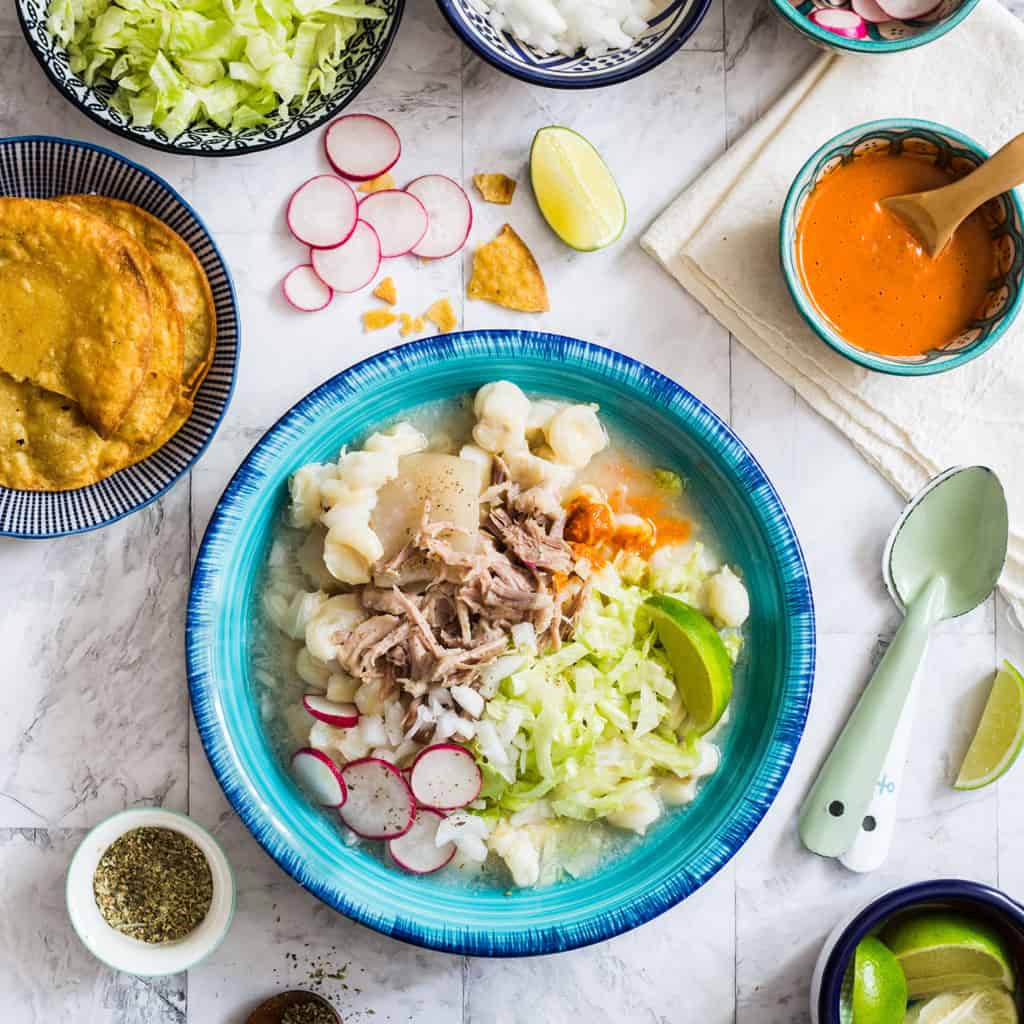
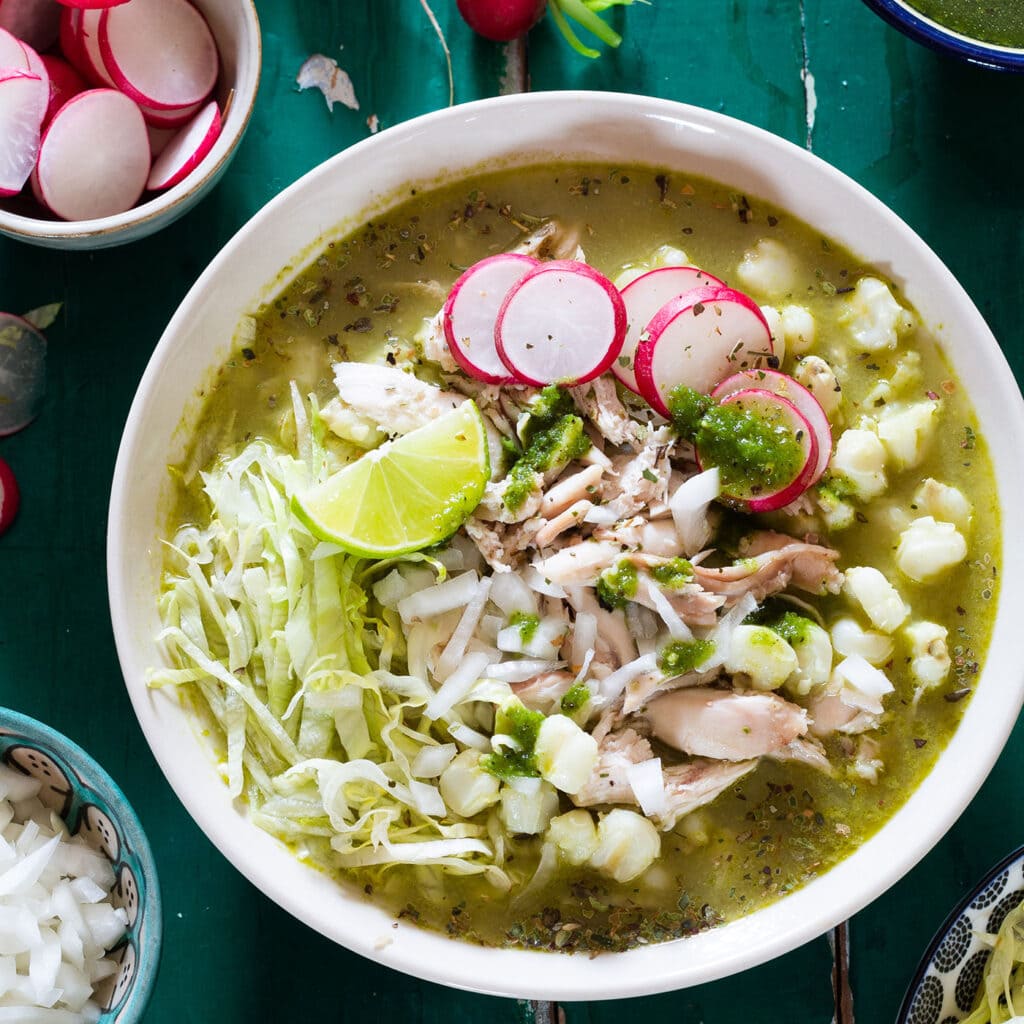
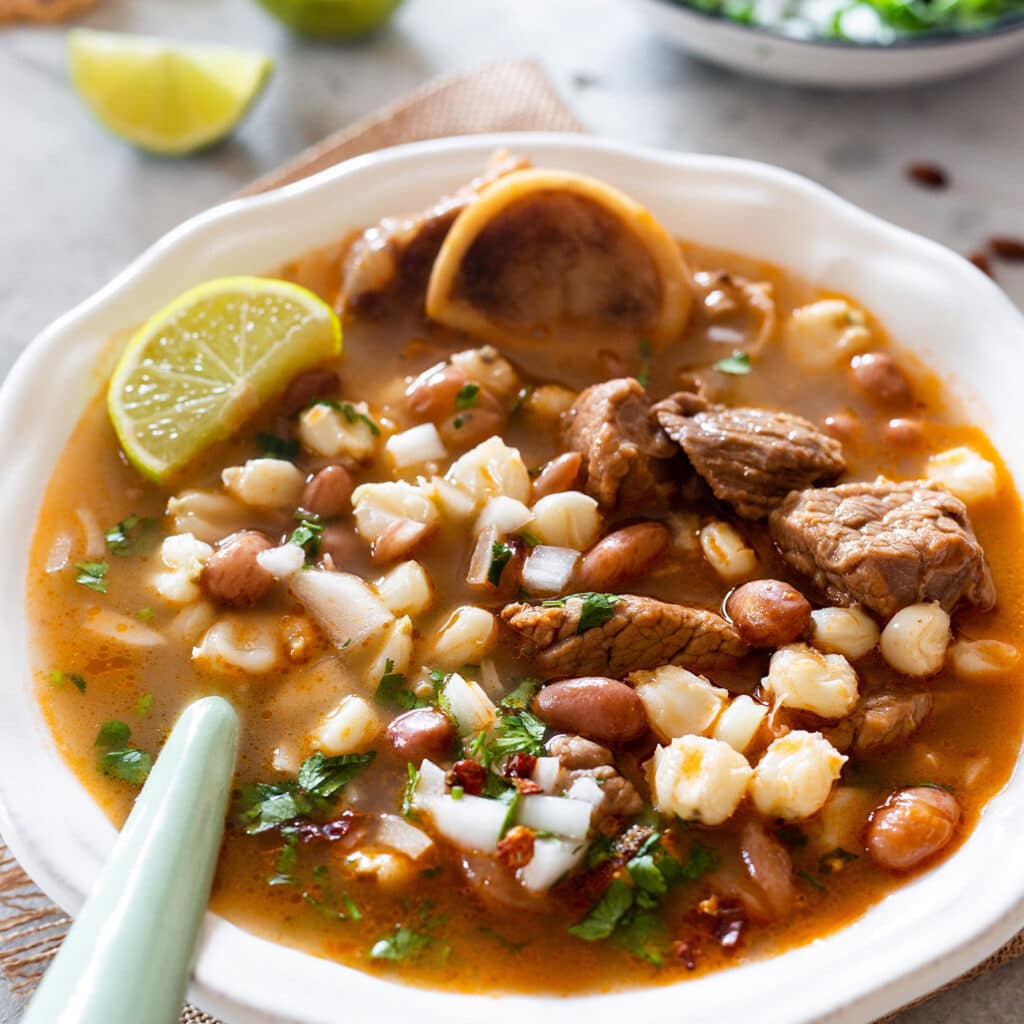
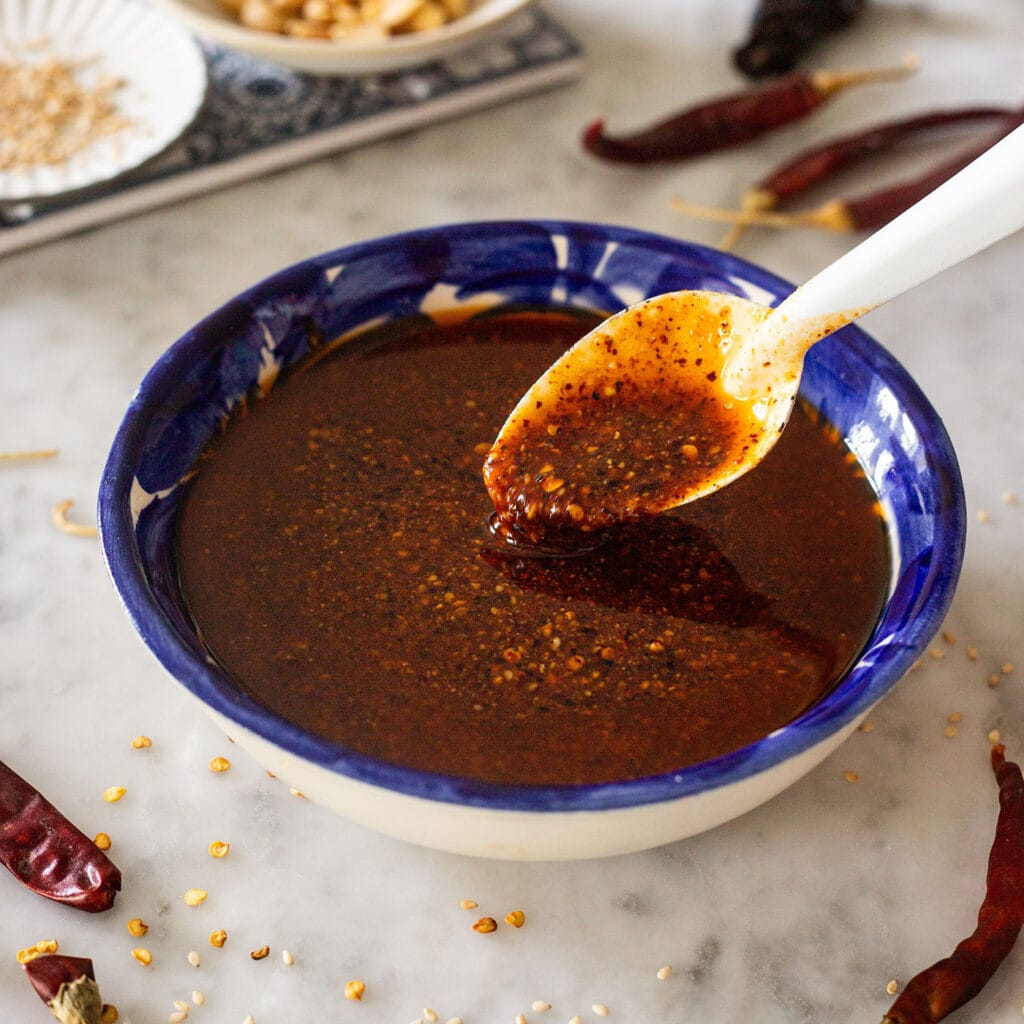

This was sooo good! My husband was so impressed when I made this for him! Tastes authentic and full of flavor!
I loved the intense flavors in this soup! So good.
I recently tried this and was blown away by its rich flavors and hearty ingredients. The tender pork, hominy, and savory broth combined perfectly to create a truly authentic and satisfying dish.
This was everything a gourmet meal should be, and then some! Was hearty and delicious; easily, a new favorite dish!
Such a really comforting meal! Everyone loved it!
OOH this looks delightful! I’m going to try this one soon. And your pictures are beautiful!
There are so many different textures and flavors in this. I loved every single spicy bite of it!
I’ve never tried pozole rojo before, but I’ve heard people rave about it. I’m excited to make this next week for my family!
The richness and depth of flavor were outstanding. Each spoonful was a burst of vibrant taste, and the spice level was just perfect. It’s the ultimate comfort food and ideal for gatherings.
This is such an amazing and comforting recipe! I will definitely make it again soon!
Been too long since we had this. Using hominy in ours this weekend, this sounds so good!! Thank you!
Wow, your Pozole Rojo is a flavor bomb! The spices were perfectly balanced, and the texture was spot-on. I’ve tried making pozole before, but it never turned out this good. You’ve got some serious kitchen skills—thanks for sharing this gem of a recipe!
I adore pozole rojo, but only ever get it in restaurants. Now I can make it at home so I’ll be having it often!
My forever comfort food! It is so flavorful and comforting, just the way I like it,
I made this pozole for dinner last night and it was incredible! So full of authentic flavor!
Love the combination of ingredients in this recipe. So flavorful and delicious.
Seriously amazing. This is going to be saved and made over and over again. Thank you!
Such a great recipe for feeding a crowd and so many delicious flavours. My family love trying new Mexican dishes and this is perfect.
This pozole was so satisfying, flavorful and delicious!! Our whole family loved this recipe!
I started with your white Pozole recipe when I had some vegetarian friends over for dinner. My mom made a quick version of red Pozole from canned hominy, and it was always my favorite in the winter months. I’m stationed overseas, and ordered the cacahuazintle and made the white Pozole from scratch. This recipe is now my favorite, just don’t tell my mom!
Thank you Eric, your comment means a lot to me <3
This pozole rojo looks so tempting. Just not sure if I can find every ingredient listed in the recipe :(
Pozole Rojo is a awesome maxican food to serve in this summer.thanks for the recipe
Wonderful recipe. Thanks for sharing! Not sure if I can find all ingredients but I’d love to try it.